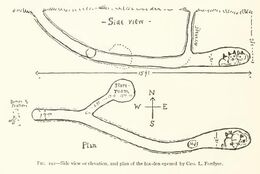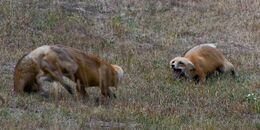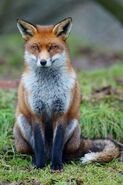The red fox (Vulpes vulpes) is the largest of the true foxes and the most abundant wild member of the Carnivora, being present across the entire Northern Hemisphere from the Arctic Circle to North Africa, North America and Eurasia. It is listed as least concern by the IUCN. Its range has increased alongside human expansion, having been introduced to Australia, where it is considered harmful to native mammals and bird populations. Due to its presence in Australia, it is included among the list of the "world's 100 worst invasive species".
The red fox originated from smaller-sized ancestors from Eurasia during the Middle Villafranchian period, and colonised North America shortly after the Wisconsin glaciation. Among the true foxes, the red fox represents a more progressive form in the direction of carnivory. Apart from its large size, the red fox is distinguished from other fox species by its ability to adapt quickly to new environments. Despite its name, the species often produces individuals with other colourings, including albinos and melanists. Forty-five subspecies are currently recognised, which are divided into two categories: the large northern foxes, and the small, basal southern foxes of Asia and the Middle East.
Red foxes are usually together in pairs or small groups consisting of families, such as a mated pair and their young, or a male with several females having kinship ties. The young of the mated pair remain with their parents to assist in caring for new kits. The species primarily feeds on small rodents, though it may also target rabbits, game birds, reptiles, invertebrates and young ungulates. Fruit and vegetable matter is also eaten sometimes. Although the red fox tends to kill smaller predators, including other fox species, it is vulnerable to attack from larger predators, such as wolves, coyotes, golden jackals and medium- and large-sized felines.
The species has a long history of association with humans, having been extensively hunted as a pest and furbearer for many centuries, as well as being represented in human folklore and mythology. Because of its widespread distribution and large population, the red fox is one of the most important furbearing animals harvested for the fur trade. Too small to pose a threat to humans, it has successfully colonised many suburban areas. It is the only fox native to Western Europe, and so is simply called "the fox" in colloquial British English.
Origins[]
The species is Eurasian in origin, and may have evolved from either Vulpes alopecoides or the related Chinese V. chikushanensis, both of which lived during the Middle Villafranchian. The earliest fossil specimens of V. vulpes were uncovered in Barany, Hungary dating from 3.4 to 1.8 million years ago. The ancestral species was likely smaller than the current one, as the earliest red fox fossils are smaller than modern populations. The earliest fossil remains of the modern species date back to the mid-Pleistocene in association with the refuse of early human settlements. This has led to the theory that the red fox was hunted by primitive humans as both a source of food and pelts.
Colonisation of North America[]
Red foxes colonised the North American continent in two waves: during or before the Illinoian glaciation, and during the Wisconsinan glaciation. Gene mapping demonstrates that red foxes in North America have been isolated from their Old World counterparts for over 400,000 years, thus raising the possibility that speciation has occurred, and that the previous binomial name of Vulpes fulva may be valid. In the far north, red fox fossils have been found in Sangamonian deposits in the Fairbanks District and Medicine Hat. Fossils dating from the Wisconsian are present in 25 sites in Arkansas, California, Colorado, Idaho, Missouri, New Mexico, Tennessee, Texas, Virginia, and Wyoming. Although they ranged far south during the Wisconsinan, the onset of warm conditions shrank their range toward the north, and have only recently reclaimed their former American ranges because of human-induced environmental changes. Genetic testing indicates two distinct red fox refugia exist in North America, which have been separated since the Wisconsinan. The northern (or boreal) refugium occurs in Alaska and western Canada, and consists of the large subspecies V. v. alascensis, V. v. abietorum, V. v. regalis, and V. v. rubricosa. The southern (or montane) refugium occurs in the subalpine parklands and alpine meadows of the Rocky Mountains, the Cascade Range, and Sierra Nevada. It encompasses the subspecies V. v. macroura, V. v. cascadensis, and V. v. necator. The latter clade has been separated from all other red fox populations since the last glacial maximum, and may possess unique ecological or physiological adaptations.
Although European foxes were introduced to portions of the United States in the 18th century, recent genetic investigation indicates an absence of European fox haplotypes in any North American populations. Also, introduced eastern red foxes have colonized southern California, the San Joaquin Valley, and San Francisco Bay Area, but appear to have mixed with the Sacramento Valley red fox V. v. patwin only in a narrow hybrid zone. In addition, no evidence is seen of interbreeding of eastern red foxes in California with the montane Sierra Nevada red fox V. v. necator or other populations in the Intermountain West (between the Rocky Mountains to the east and the Cascade and Sierra Nevada ranges to the west.
Dimensions[]
Red foxes are the largest species of the genus Vulpes. However, relative to dimensions, red foxes are much lighter than similarly sized dogs of the genus Canis. Their limb bones, for example, weigh 30% less per unit area of bone than expected for similarly sized dogs. They display significant individual, sexual, age and geographical variation in size. On average, adults measure 35–50 cm (14–20 in) high at the shoulder and 45 to 90 cm (18 to 35 in) in body length with tails measuring 30 to 55.5 cm (11.8 to 21.9 in). The ears measure 7.7–12.5 cm (3–5 in) and the hind feet 12–18.5 cm (5–7 in). Weights range from 2.2 to 14 kg (4.9 to 30.9 lb), with vixens typically weighing 15–20% less than males. Adult red foxes have skulls measuring 129–167 mm (5.1–6.6 in), while those of vixens measure 128–159 mm (5.0–6.3 in). The forefoot print measures 60 mm (2.4 in) in length and 45 mm (1.8 in) in width, while the hind foot print measures 55 mm (2.2 in) long and 38 mm (1.5 in) wide. They trot at a speed of 6–13 km/h, and have a maximum running speed of 50 km/h. They have a stride of 25–35 cm (9.8–13.8 in) when walking at a normal pace. North American red foxes are generally lightly built, with comparatively long bodies for their mass and have a high degree of sexual dimorphism. British red foxes are heavily built, but short, while continental European red foxes are closer to the general average among red fox populations. The largest red fox on record in Great Britain was a 17.2 kg (38.1 lbs), 1.4-metre (4 ft 7 in) long male, killed in Aberdeenshire, Scotland in early 2012.
Fur[]
The winter fur is dense, soft, silky and relatively long. For the northern foxes, the fur is very long, dense and fluffy, but is shorter, sparser and coarser in southern forms. Among northern foxes, the North American varieties generally have the silkiest guard hairs, while most Eurasian red foxes have coarser fur. There are three main colour morphs; red, silver/black and cross (see Mutations). In the typical red morph, their coats are generally bright reddish-rusty with yellowish tints. A stripe of weak, diffuse patterns of many brown-reddish-chestnut hairs occurs along the spine. Two additional stripes pass down the shoulder blades, which, together with the spinal stripe, form a cross. The lower back is often a mottled silvery colour. The flanks are lighter coloured than the back, while the chin, lower lips, throat and front of the chest are white. The remaining lower surface of the body is dark, brown or reddish. During lactation, the belly fur of vixens may turn brick red. The upper parts of the limbs are rusty reddish, while the paws are black. The frontal part of the face and upper neck is bright brownish-rusty red, while the upper lips are white. The backs of the ears are black or brownish-reddish, while the inner surface is whitish. The top of the tail is brownish-reddish, but lighter in colour than the back and flanks. The underside of the tail is pale grey with a straw-coloured tint. A black spot, the location of the supracaudal gland, is usually present at the base of the tail. The tip of the tail is white.
Behavior[]
Social and territorial behaviour[]
Red foxes either establish stable home ranges within particular areas or are itinerant with no fixed abode. They use their urine to mark their territories. A male fox raises one hind leg and his urine is sprayed forward in front of him, whereas a female fox squats down so that the urine is sprayed in the ground between the hind legs. Urine is also used to mark empty cache sites, used to store found food, as reminders not to waste time investigating them. The use of up to 12 different urination postures allows them to precisely control the position of the scent mark. Red foxes live in family groups sharing a joint territory. In favourable habitats and/or areas with low hunting pressure, subordinate foxes may be present in a range. Subordinate foxes may number 1 or 2, sometimes up to 8 in one territory. These subordinates could be formerly dominant animals, but are mostly young from the previous year, who act as helpers in rearing the breeding vixen's kits. Alternatively, their presence has been explained as being in response to temporary surpluses of food unrelated to assisting reproductive success. Non-breeding vixens will guard, play, groom, provision and retrieve kits, an example of kin selection. Red foxes may leave their families once they reach adulthood if the chances of winning a territory of their own are high. If not, they will stay with their parents, at the cost of postponing their own reproduction.
Reproduction and development[]
Red foxes reproduce once a year in spring. Two months prior to oestrus (typically December), the reproductive organs of vixens change shape and size. By the time they enter their oestrus period, their uterine horns double in size, and their ovaries grow 1.5–2 times larger. Sperm formation in males begins in August–September, with the testicles attaining their greatest weight in December–February. The vixen's oestrus period lasts three weeks, during which the dog-foxes mate with the vixens for several days, often in burrows. Copulation is accompanied by a copulatory tie, which may last for more than an hour. The copulatory tie occurs when the male's bulbus glandisenlarges. The gestation period lasts 49–58 days. Though foxes are largely monogamous, DNA evidence from one population indicated large levels of polygyny, incest and mixed paternity litters. Subordinate vixens may become pregnant, but usually fail to whelp, or have their kits killed postpartum by either the dominant female or other subordinates.
The average litter size consists of four to six kits, though litters of up to 13 kits have occurred. Large litters are typical in areas where fox mortality is high. Kits are born blind, deaf and toothless, with dark brown fluffy fur. At birth, they weigh 56–110 g (2.0–3.9 oz) and measure 14.5 cm (5.7 in) in body length and 7.5 cm (3.0 in) in tail length. At birth, they are short-legged, large-headed and have broad chests. Mothers remain with the kits for 2–3 weeks, as they are unable to thermoregulate. During this period, the fathers or barren vixens feed the mothers. Vixens are very protective of their kits, and have been known to even fight off terriers in their defence. If the mother dies before the kits are independent, the father takes over as their provider. The kits' eyes open after 13–15 days, during which time their ear canals open and their upper teeth erupt, with the lower teeth emerging 3–4 days later. Their eyes are initially blue, but change to amber at 4–5 weeks. Coat colour begins to change at 3 weeks of age, when the black eye streak appears. By one month, red and white patches are apparent on their faces. During this time, their ears erect and their muzzles elongate. Kits begin to leave their dens and experiment with solid food brought by their parents at the age of 3–4 weeks. The lactation period lasts 6–7 weeks. Their woolly coats begin to be coated by shiny guard hairs after 8 weeks. By the age of 3–4 months, the kits are long-legged, narrow-chested and sinewy. They reach adult proportions at the age of 6–7 months. Some vixens may reach sexual maturity at the age of 9–10 months, thus bearing their first litters at one year of age. In captivity, their longevity can be as long as 15 years, though in the wild they typically do not survive past 5 years of age.
Denning Behavior[]

Drawing of Red Fox Den.
Outside the breeding season, most red foxes favour living in the open, in densely vegetated areas, though they may enter burrows to escape bad weather. Their burrows are often dug on hill or mountain slopes, ravines, bluffs, steep banks of water bodies, ditches, depressions, gutters, in rock clefts and neglected human environments. Red foxes prefer to dig their burrows on well drained soils. Dens built among tree roots can last for decades, while those dug on the steppes last only several years. They may permanently abandon their dens during mange outbreaks, possibly as a defence mechanism against the spread of disease. In the Eurasian desert regions, foxes may use the burrows of wolves, porcupines and other large mammals, as well as those dug by gerbil colonies. Compared to burrows constructed by Arctic foxes, badgers, marmots and corsac foxes, red fox dens are not overly complex. Red fox burrows are divided into a den and temporary burrows, which consist only of a small passage or cave for concealment. The main entrance of the burrow leads downwards (40–45°)
and broadens into a den, from which numerous side tunnels branch. Burrow depth ranges from 0.5–2.5 metres (1 ft 8 in–8 ft 2 in), rarely extending to ground water. The main passage can reach 17 m (56 ft) in length, standing an average of 5–7 m (16–23 ft). In spring, red foxes clear their dens of excess soil through rapid movements, first with the forepaws then with kicking motions with their hind legs, throwing the discarded soil over 2 m (6 ft 7 in) from the burrow. When kits are born, the discarded debris is trampled, thus forming a spot where the kits can play and receive food. They may share their dens with woodchucks or badgers. Unlike badgers, which fastidiously clean their earths and defecate in latrines, red foxes habitually leave pieces of prey around their dens. The average sleep time of a captive red fox is 9.8 hours per day.
Communication[]
Body Language[]
Red fox body language consists of movements of the ears, tail and postures, with their body markings emphasising certain gestures. Postures can be divided into aggressive/dominant and fearful/submissive categories. Some postures may blend the two together.

A pair of Wasatch mountain foxes squabbling.
Inquisitive foxes will rotate and flick their ears whilst sniffing. Playful individuals will perk their ears and rise on their hind legs. Male foxes courting females, or after successfully evicting intruders, will turn their ears outwardly, and raise their tails in a horizontal position, with the tips raised upward. When afraid, red foxes grin in submission, arching their backs, curving their bodies, crouching their legs and lashing their tails back and forth with their ears pointing backwards and pressed against their skulls. When merely expressing
submission to a dominant animal, the posture is similar, but without arching the back or curving the body. Submissive foxes will approach dominant animals in a low posture, so that their muzzles reach up in greeting. When two evenly matched foxes confront each other over food, they approach each other sideways and push against each other's flanks, betraying a mixture of fear and aggression through lashing tails and arched backs without crouching and pulling their ears back without flattening them against their skulls. When launching an assertive attack, red foxes approach directly rather than sideways, with their tails aloft and their ears rotated sideways. During such fights, red foxes will stand on each other's upper bodies with their forelegs, using open mouthed threats. Such fights typically only occur among juveniles or adults of the same sex.




















